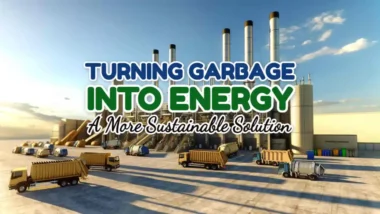Embrace a greener holiday season with these 7 easy steps! Yes, it's your article about the top 7 Eco Friendly Christmas Tips!
Are you wondering how to make your Christmas celebration greener? A shocking fact: during the holiday season, waste in landfills increases by 25%. This article offers seven practical and easy-to-follow tips to reduce that number next Christmas.
Get ready to celebrate sustainably!
Key Takeaways
- Choose local and fresh food to cut down on carbon emissions. This helps the environment by reducing the need for long transport.
- Use decorations that last longer or reuse old ones to lessen waste. Simple changes like using LED lights save energy.
- Give presents made from sustainable materials or make your own gifts. This reduces waste and cuts down on pollution from manufacturing and transporting goods.
- Plan your meals and shopping list carefully to avoid buying too much. This stops food from being wasted.
- Recycle or upcycle items instead of throwing them away. Teaching kids about these practices can inspire everyone to care more for our planet.
Importance of an Eco-Friendly Christmas
An eco-friendly Christmas plays a crucial role in tackling the spike in waste and litter seen during the December holiday period. This time of year traditionally results in a landfill increase of 25% more rubbish, adding significantly to global warming through harmful off-gassing processes.
Choosing sustainable practices can greatly diminish these impacts, promoting a healthier environment for us all.
Making small changes can lead to big environmental benefits – like reducing carbon emissions, minimising plastic pollution, and cutting down on food waste. These actions contribute not only to a festive season that's kinder on our planet but also inspire others around us to rethink their habits.
Embracing an eco-friendly Christmas means celebrating with care for the world we share, ensuring it remains vibrant and healthy for future generations.

Tips for an Earth-Friendly Christmas

Making your Christmas celebration green doesn't have to be a chore – it's about smart, simple swaps and choices. Dive into these tips to find out how small changes can make a big difference for our planet this festive season.
Buy local and fresh
Choosing to buy local and fresh produce is a key step towards an earth-friendly Christmas. It supports your community's farmers and reduces the carbon footprint associated with transporting food from afar.
Think about it—food that doesn't travel long distances doesn't require as much fuel or generate as many greenhouse gas emissions. This means every plate of food contributes to lower carbon emissions, making your holiday meals more sustainable.
Opting for items grown close to home also ensures you're getting fresher, tastier ingredients for your festive dishes. Besides being good for the planet, it's good for your taste buds too! You'll find that local markets are filled with seasonal vegetables and fruits which can inspire traditional and innovative Christmas recipes alike.
Not only does this practice promote a zero-waste lifestyle by reducing packaging, but it also helps in cutting back on single-use plastics commonly found in supermarket goodies. So next time you plan your festive menu, consider how choosing locally sourced produce can make a world of difference—for both the environment and your dining experience.
Trim food shopping
After choosing to buy local and fresh, taking the next step to trim food shopping can make a big difference. Planning meals carefully means buying only what you need. This approach not only saves money but also reduces waste significantly.
The December holiday period sees an increase in landfill litter by 25%, much of which comes from excess food that could have been avoided with better planning.
Creating a shopping list before heading to the store stops impulse buys—items that often go unused and end up in the bin. Look into your fridge and cupboards first; use what you already have at home.
By doing this, you're directly cutting down on overconsumption and energy usage, making for a more eco-friendly Christmas celebration that's kinder to our planet.
Say no to wrapping paper
Wrapping paper might look pretty under the Christmas tree, but it's a major contributor to holiday waste. Every year, the use of wrapping paper leads to a 25% increase in landfill waste.
This not only takes up space but also contributes to global warming through off-gassing. By choosing not to use traditional wrapping paper, we can make a significant dent in reducing this seasonal spike in pollution.
Opt for eco-friendly alternatives instead. Ideas like reusing old newspapers, crafting gift bags from fabric scraps, or even using children’s artwork give gifts a personal touch while protecting the environment.
These options help minimise environmental impact and support a zero-waste lifestyle during the festive season. Let's embrace these sustainable practices and turn our backs on disposable wrapping options that harm our planet.
Opt for quality over quantity
Moving away from the habit of using wrapping paper leads us directly into another eco-friendly practice – choosing quality over quantity. This approach is not just about gifts, but also decorations and even how we plan our Christmas meals.
Instead of buying lots of inexpensive items that won't last, invest in fewer, high-quality products that you can enjoy for years to come. This might mean selecting durable decorations that don't need to be replaced every year or opting for well-made gifts that hold more meaning.
Focusing on quality helps reduce waste significantly. It encourages us to think carefully about what we're purchasing and why. For instance, instead of grabbing the first decoration you see on sale, search for something made with care and designed to last longer.
Or when choosing gifts, consider items that the receiver will truly value and use over time – perhaps something handcrafted or personalised. This way, you're not only being kinder to the environment but also giving more thoughtful presents that avoid the cycle of fast fashion and disposable goods.
Re-use Christmas decorations

Choosing decorations that last longer isn't the only way to celebrate Christmas sustainably. Another brilliant step is re-using your current set of decorations. This practice significantly cuts down on waste and reduces energy consumption, crucial during the festive season when landfill litter increases by 25%.
Instead of buying new baubles or tinsel each year, get creative with what you already have. You can refresh old decorations with a bit of paint or new ribbons—turning them into unique pieces.
Digging out those lights and ornaments from previous years not only saves you money but also honors the spirit of an eco-friendly holiday. It's all about making less impact on our planet while keeping traditions alive.
Reusing might mean that your Christmas setup looks similar year after year, but it also means you're contributing to a bigger cause—reducing plastic waste and helping slow down environmental damage.
Get family members involved in upcycling projects for fun ways to breathe new life into cherished items, fostering both creativity and awareness among loved ones.
Time Christmas lights
Timing Christmas lights wisely is a simple yet effective way to cut down on energy consumption and waste. Invest in a timer for your fairy lights. This ensures they're only on when needed, reducing unnecessary use and helping save on electricity bills.
It's an action that aligns with the broader goal of having an eco-friendly Christmas by lessening our carbon footprint.
Using LED lights instead of traditional ones can also make a big difference. They use up to 75% less energy and last 25 times longer. This switch not only conserves energy but also contributes to fewer emissions from power plants, tackling global warming head-on.
Such small changes in how we celebrate can significantly impact our efforts to protect the environment during the festive season.
Purchasing and Making Long-Lasting Gifts
Choose gifts that will stand the test of time to really make an impact this Christmas. Opting for quality items means they're less likely to end up in the bin after a few uses. This not only saves you money in the long run but also reduces waste massively.
Consider products made from sustainable materials or those offering energy savings, like LED lights or solar-powered gadgets.
Making your own presents adds a personal touch and cuts down on manufacturing pollution and transport emissions. Use recycled materials, aim for zero waste creations, or bake something delicious as an eco-friendly alternative.
Sharing car journeys when buying supplies, or better yet, using public transport helps lower your carbon footprint further. Handmade gifts are not just special; they encourage a more thoughtful and environmentally conscious approach to gift-giving.

Recycling and Reusing Items
Recycling and reusing items during Christmas can drastically reduce the 25% landfill increase seen in the December holiday period. Consider regifting items that are still in good condition or donating them to charity shops.
This approach not only clears out unused items from your home but also provides others with joy. Get creative by upcycling decorations or turning old fabrics into unique gift wraps, proving that recycling can be both fun and impactful.
Crafting homemade gifts from recycled materials sends a powerful message about valuing sustainability over consumerism. It's a thoughtful way of showing love while protecting our planet.
Encourage family and friends to join in on these practices, sharing tips through YouTube videos or carpooling to crafting sessions. Reusing plastic bottles as containers for homemade plant-based treats adds an extra touch of personal care to your eco-friendly Christmas initiatives, making this festive season memorable for all the right reasons.
Being a Good Role Model for Eco-Friendly Practices
Adults have a powerful role in shaping the future by showing kids how to live in harmony with our planet. It starts with small, daily actions that underline the importance of reducing energy consumption and cutting down on waste.
Teach them to choose bike-sharing over car journeys whenever possible. Highlight the benefits of drinking from reusable water bottles instead of buying single-use plastic ones. These practices not only save money but also protect our environment.
Sharing YouTube videos on eco-friendly innovations can inspire both young and old to adopt more sustainable habits. Encouraging family and friends to invest in quality, long-lasting items rather than opting for disposable alternatives makes a big difference too.
It’s about leading by example—choosing an artificial Christmas tree that can be reused every year, or demonstrating how easy it is to recycle correctly. This approach helps everyone understand their impact on the environment and encourages them to make positive changes in their lives.

Conclusion
Let's make next Christmas greener, shall we? These seven tips are your starting blocks to a festive season that loves the Earth as much as it does celebration. Buying local, trimming waste, and choosing durable gifts can transform our holiday impact.
So, cheers to a brighter, eco-friendly future—where every Christmas counts for more than just presents under the tree. Together, let's turn this dream into our new reality.
FAQs
1. How can I reduce energy consumption during Christmas?
You can go green by using energy-efficient lights for your Christmas decorations, and turning them off when not needed. Also, consider vegan options for your meals to lessen the impact on the environment. Every little change helps!
2. Is sharing car journeys a good way to be eco-friendly at Christmas?
Absolutely! Sharing car journeys reduces CO2 emissions significantly, making it a great choice for visiting friends and family over the holidays. If possible, using trains or subways is even better for cutting down on fuel usage.
3. Are there eco-friendly alternatives to traditional Christmas dinnerware?
Yes, ditch single-use items and opt for recyclable or second-hand dinnerware instead. This move will help in creating a waste-free celebration without sacrificing style or function.
4. Can changing my food choices this Christmas help the environment?
Definitely! Choosing veggie over meats and exploring vegan dishes could greatly decrease your carbon footprint since livestock farming has major impacts on our planet's health.
5. What should I do about my Christmas tree if I want an eco-friendly holiday?
Opting for an artificial Christmas tree you can reuse every year is one smart option — just make sure it’s made from recyclable materials! Alternatively, buying from local growers who plant more trees offsets deforestation risks.
6. How does avoiding plastic straws contribute to an eco-friendly Christmas?
Ditching plastic straws in favor of drinking straws made from environmentally friendly materials such as bamboo helps combat pollution—every small action adds up towards a greener planet.







